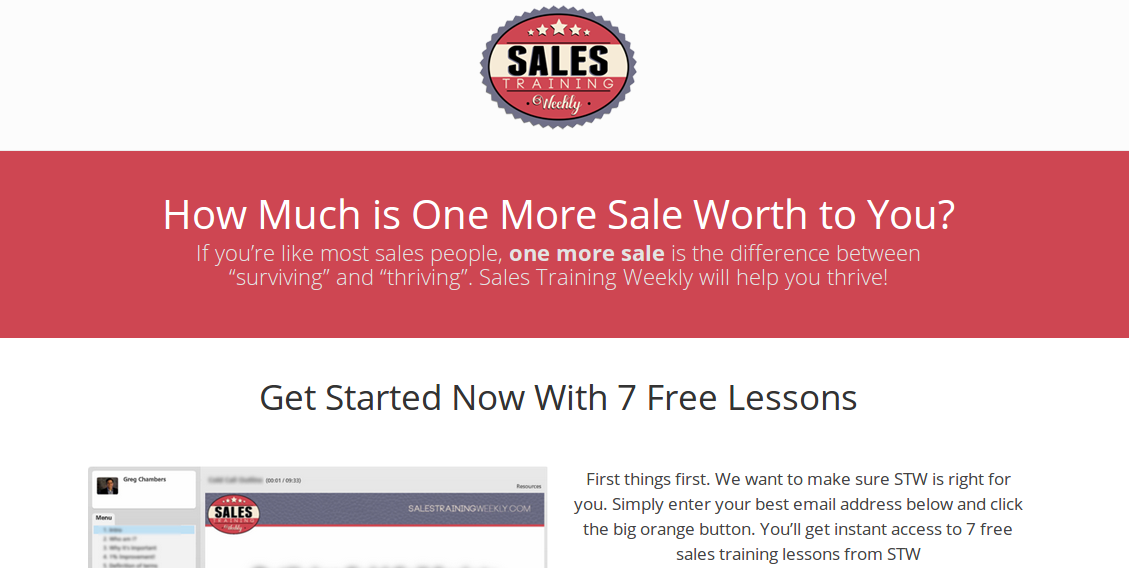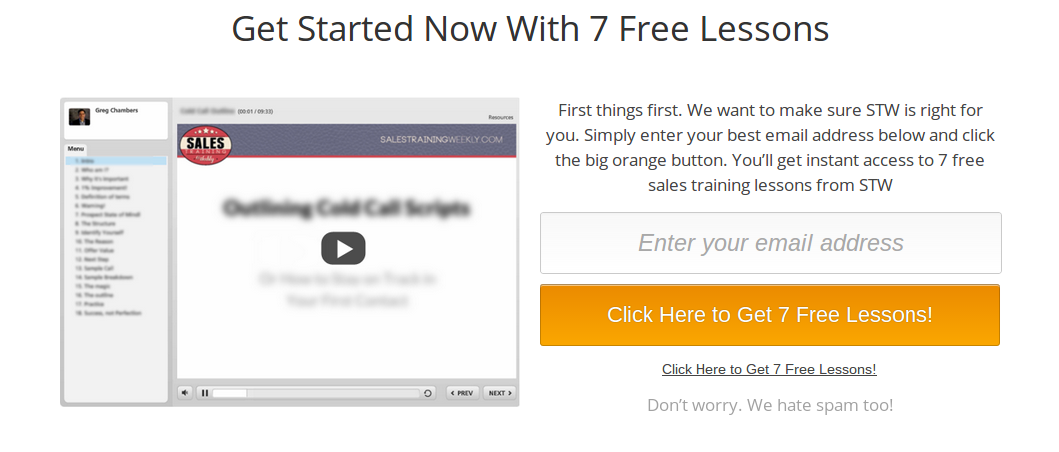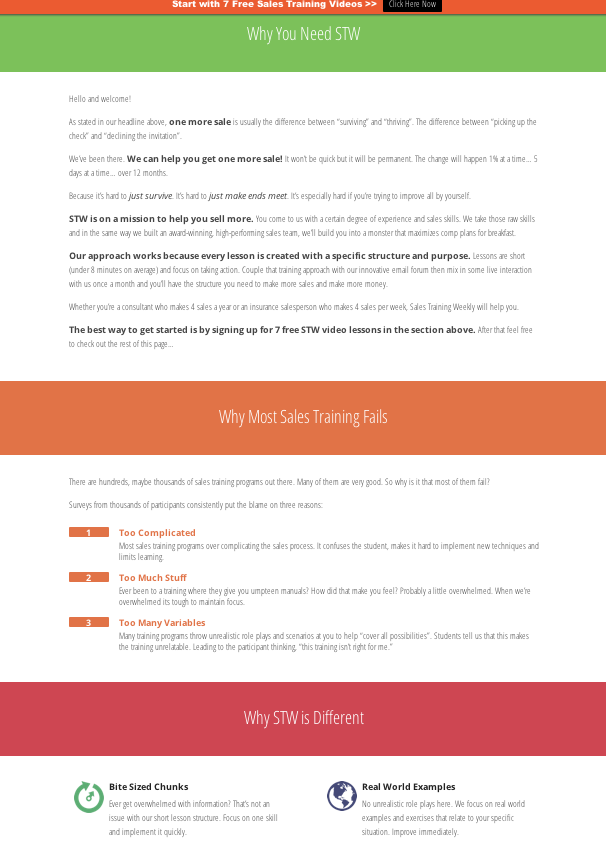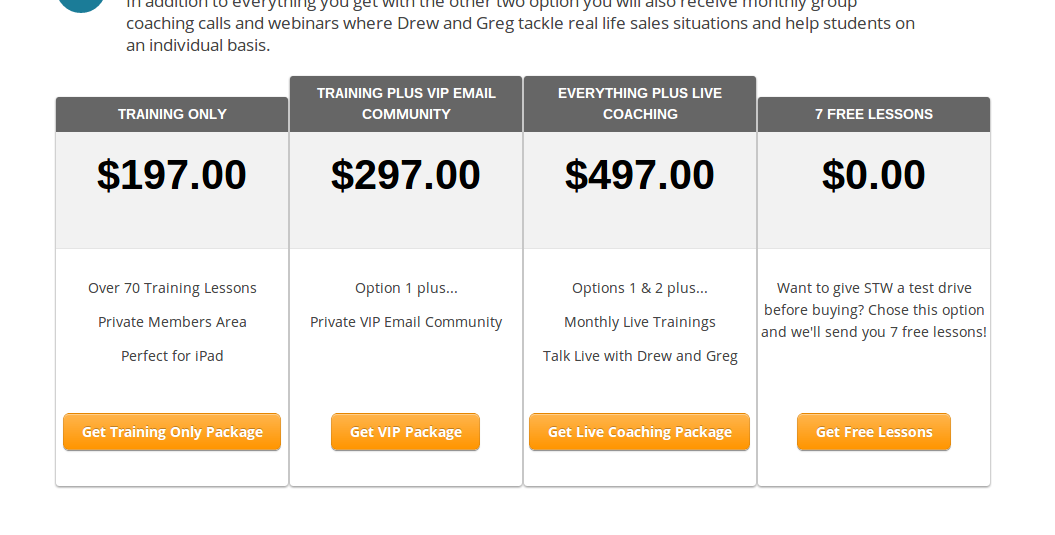The Sales Training Weekly Landing Page
The Sales Training Weekly Landing Page
We’re about a week away from launching our self-paced online sales training tool, Sales Training Weekly. As Drew hammers away at the back end of the program, we’ve started working on the main selling page. The “landing page” in common internet marketer parlance.
You can view the landing page here: http://www.salestrainingweekly.com and I’ll be working through some of the points with pictures from the page in the rest of this post. Since this is our “A” or starting point, we’re making a lot of assumptions. Once we have some data we’ll start tweaking the traffic and the messaging in order to maximize the conversion rate. If a few months pass without a follow up post, remind me to get the stats up. That’s a benefit of this project – the ability to share data with anyone who’s interested.
Let’s start with some of my definitions and run through my framework.
Target User: in this case it’s our prospective customer. In a perfect world, all of our users are in the target market.
Landing Page: simply the web page that a user lands on when they arrive on the site. For this project, it’s also the home page.
Relevancy: our quest to be meaningful. When a user lands on the page, we want the content to be what they’d expect to see and read.
Call to Action: the user has expectations and so do we. The call to action is our request to get them to the next step in the process.
Value Proposition: in order to help the process along, we try to make a fair trade of information in order to stay in touch.
Now that we’re on the same page, let’s talk about the framework. We started this project with a target market in mind, and we have identified some initial sources of traffic from that market. Those users are directed to the landing page where we explain the problem we can solve, describe the solution, offer to build value by giving something away and then ask for a commitment.
Where does it start? Technically with the target market and the invitation. In our case, we’re targeting small businesses, micro businesses and solo entrepreneurs that don’t have the resources (time and money) for a traditional sales training and coaching engagement. These users have had a short intro to the main selling point of the product: an offer to try some self-paced, focused, short duration sales training lessons that promise incremental improvement over time.
Once they click that invitation, they come to the headline:
“How Much Is One More Sale Worth to You?” is our first attempt at building value. Speaking from experience, small increases in productivity are the difference between surviving and thriving. We want to help our users thrive. Of course.
From there we go right into our first call to action: 7 free sales training lessons. Why 7? *burp* why not?!? The program has nearly 100 lessons outlined and we recommend 70 lessons taken once every 5 days, so 7 seemed like a nice freebie. Our second attempt at building value. If they dig into the lessons, they should see a 7% increase in sales skill. (it’s a long story but we have a 1% improvement message that drives the program)
Most users will need more than a snappy headline and an offer of 7 free lessons of unknown value. That’s what we spend the rest of the page working on. Answering every question that our focus group threw out as well as anticipating questions.
I know, it’s a lot of text. If you’re not in the target user demographic, you’re gone. We know that. The only people who would take the time to read every inch of that page are our target market users who are interested in improving their sales skills. Their main question?
Will this work for me?
Without a lot more information, I have no idea if it will help them. So we offer up the free lessons again. A drop down Call to Action, a lot of text calls to action that all suggest the user starts with the free sales training. If the user watches those lessons, they’ll know whether or not we can help.
That brings up their second question:
How much?
We put this at the bottom of the page because, just like a sales proposal, users have a tendency to scan the page and jump down to the bottom to find evidence that we’re going to be in the same ballpark.
We have 3 options for the training. Our preferred method of training uses the self-paced videos, an interactive email forum and live interaction with coaches. If that’s not in the budget we can remove the most expensive part, live interaction with us, and reduce the price. And if that’s not in the budget we can take away all interactive options and have the user access the video lessons. At the very least, they get 7 random lessons and maybe one of them helps in some way.
So far we’ve had a half dozen random Free Lesson sign ups from 24 visits. Without knowing how they got there (direct link) it’s hard to say if they’re in our target market. . .yet.
I’ll keep you posted when we have some data and start to improve our results.
It’s like my own little case study!
Good stuff.
About the Author: Greg Chambers is Chambers Pivot Industries. Get more business development ideas from Greg on Twitter.





